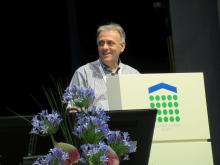LUGANO, SWITZERLAND – Patients with relapsed/refractory primary mediastinal large B-cell lymphoma (PMBCL) have few good therapeutic options, but pembrolizumab (Keytruda) may be one of them, an interim analysis from a phase 2 trial suggests.
Six of 10 patients with relapsed/refractory PMBCL for whom autologous stem cell transplantation (ASCT) had failed had responses to salvage therapy with pembrolizumab, including three complete responses (CR) and three partial responses (PR), reported Pier Luigi Zinzani, MD, PhD, of the University of Bologna, Italy.
“In relapsed/refractory primary mediastinal large B-cell lymphoma including heavily pretreated patients in our series, pembrolizumab showed promising antitumor activity in these preliminary data from a phase 2 study, and a manageable safety profile,” Dr. Zinzani said at the International Conference on Malignant Lymphoma.
The interim results of the phase 2 Keynote-170 trial are similar to those seen in the multicohort Keynote-013 study for patients with PMBCL and other hematologic malignancies, Dr. Zinzani said.Although standard cytotoxic chemotherapy regimens are curative in approximately 80% of patients with PMBCL, those with relapsed/refractory disease have a poor prognosis and limited treatment options. In the United States, about 200 patients are diagnosed with relapsed/refractory PMBCL each year, Dr. Zinzani noted.
The rationale for using a programmed death-1 (PD-1) inhibitor such as pembrolizumab is that PMBCL tumors frequently harbor amplifications and/or translocations in the 9p24.1 locus that lead to overexpression of PD ligand 1 (PD-L1) or PD-L2. Pembrolizumab blocks interactions between PD-1 and its ligands.
In the Keynote-013 PMBCL cohort, the objective response rate (ORR) was 48%, including 24% CR.
Keynote 170 investigators are enrolling adults with relapsed/refractory PMBCL who are either ineligible for ASCT following at least two prior lines of therapy, or who had a relapse following a transplant.
Patients receive pembrolizumab 200 mg every 3 weeks. Those who achieve a complete response are allowed to discontinue after a minimum of 24 weeks on study, those with partial response or stable disease are treated for 35 cycles or until disease progression or intolerable toxicities, and those with disease progression are discontinued, but are allowed to remain on study until progression is confirmed.
Responses are assessed by PET and CT scans according to 2007 International Working Group criteria.
Among the 29 patients assessable for efficacy at the time of Dr. Zinzani’s presentations, the best response by blinded central review was 41% (12 patients: 4 CR and 8 PR). Three patients had stable disease, and eight had disease progression. Six patients died or discontinued participation prior to the first assessment.
In all, 16 of 22 patients had reductions in target lesions, and all but one of these patients had reductions greater than 50%.
After a median follow-up of 6.6 months, 10 patients had ongoing responses. The median time to response was 2.9 months. The median duration of response has not been reached.
Of the 10 patients for whom ASCT had failed, three had a CR, and three had a PR. Among 19 ASCT-ineligible patients, one had a CR and five had a PR.
The interim safety analysis included 49 patients. Of this group, only one discontinued treatment because of adverse events. There were 26 treatment-related adverse events, but no treatment-related deaths.
The most frequent adverse events were neutropenia, asthenia, hypothyroidism, and pyrexia.
The study is supported by Merck. Dr Zinzani disclosed serving on advisory boards for several companies.


